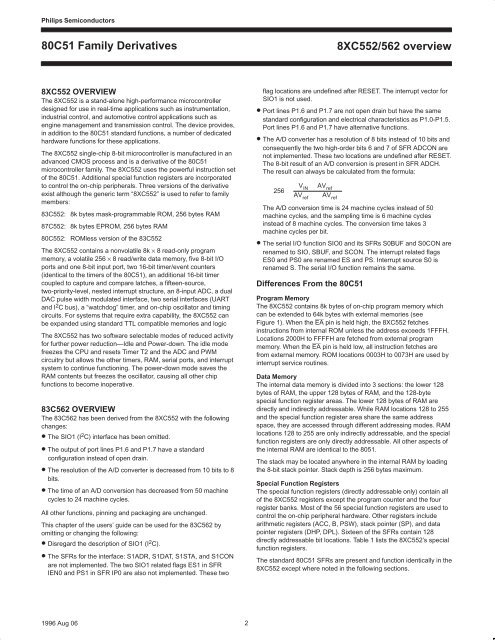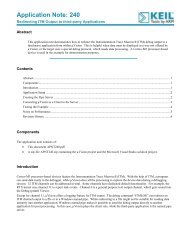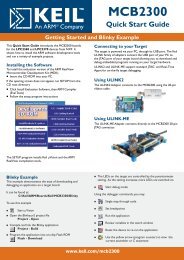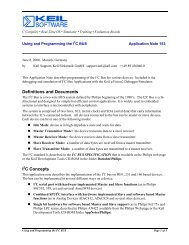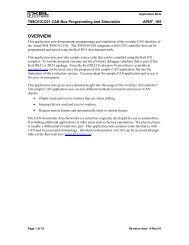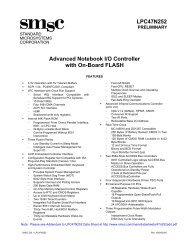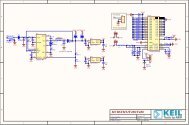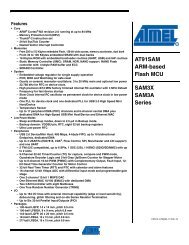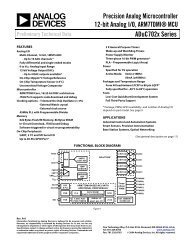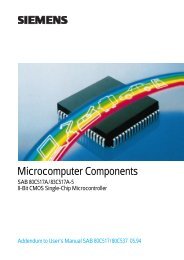NXP 80C552, 83/87C552, P80C562, P83C562 Family Overview - Keil
NXP 80C552, 83/87C552, P80C562, P83C562 Family Overview - Keil
NXP 80C552, 83/87C552, P80C562, P83C562 Family Overview - Keil
Create successful ePaper yourself
Turn your PDF publications into a flip-book with our unique Google optimized e-Paper software.
Philips Semiconductors<br />
80C51 <strong>Family</strong> Derivatives 8XC552/562 overview<br />
8XC552 OVERVIEW<br />
The 8XC552 is a stand-alone high-performance microcontroller<br />
designed for use in real-time applications such as instrumentation,<br />
industrial control, and automotive control applications such as<br />
engine management and transmission control. The device provides,<br />
in addition to the 80C51 standard functions, a number of dedicated<br />
hardware functions for these applications.<br />
The 8XC552 single-chip 8-bit microcontroller is manufactured in an<br />
advanced CMOS process and is a derivative of the 80C51<br />
microcontroller family. The 8XC552 uses the powerful instruction set<br />
of the 80C51. Additional special function registers are incorporated<br />
to control the on-chip peripherals. Three versions of the derivative<br />
exist although the generic term “8XC552” is used to refer to family<br />
members:<br />
<strong>83</strong>C552: 8k bytes mask-programmable ROM, 256 bytes RAM<br />
<strong>87C552</strong>: 8k bytes EPROM, 256 bytes RAM<br />
<strong>80C552</strong>: ROMless version of the <strong>83</strong>C552<br />
The 8XC552 contains a nonvolatile 8k × 8 read-only program<br />
memory, a volatile 256 × 8 read/write data memory, five 8-bit I/O<br />
ports and one 8-bit input port, two 16-bit timer/event counters<br />
(identical to the timers of the 80C51), an additional 16-bit timer<br />
coupled to capture and compare latches, a fifteen-source,<br />
two-priority-level, nested interrupt structure, an 8-input ADC, a dual<br />
DAC pulse width modulated interface, two serial interfaces (UART<br />
and I2C bus), a “watchdog” timer, and on-chip oscillator and timing<br />
circuits. For systems that require extra capability, the 8XC552 can<br />
be expanded using standard TTL compatible memories and logic<br />
The 8XC552 has two software selectable modes of reduced activity<br />
for further power reduction—Idle and Power-down. The idle mode<br />
freezes the CPU and resets Timer T2 and the ADC and PWM<br />
circuitry but allows the other timers, RAM, serial ports, and interrupt<br />
system to continue functioning. The power-down mode saves the<br />
RAM contents but freezes the oscillator, causing all other chip<br />
functions to become inoperative.<br />
<strong>83</strong>C562 OVERVIEW<br />
The <strong>83</strong>C562 has been derived from the 8XC552 with the following<br />
changes:<br />
• The SIO1 (I 2 C) interface has been omitted.<br />
• The output of port lines P1.6 and P1.7 have a standard<br />
configuration instead of open drain.<br />
• The resolution of the A/D converter is decreased from 10 bits to 8<br />
bits.<br />
• The time of an A/D conversion has decreased from 50 machine<br />
cycles to 24 machine cycles.<br />
All other functions, pinning and packaging are unchanged.<br />
This chapter of the users’ guide can be used for the <strong>83</strong>C562 by<br />
omitting or changing the following:<br />
• Disregard the description of SIO1 (I 2 C).<br />
• The SFRs for the interface: S1ADR, S1DAT, S1STA, and S1CON<br />
are not implemented. The two SIO1 related flags ES1 in SFR<br />
IEN0 and PS1 in SFR IP0 are also not implemented. These two<br />
1996 Aug 06<br />
2<br />
flag locations are undefined after RESET. The interrupt vector for<br />
SIO1 is not used.<br />
• Port lines P1.6 and P1.7 are not open drain but have the same<br />
standard configuration and electrical characteristics as P1.0-P1.5.<br />
Port lines P1.6 and P1.7 have alternative functions.<br />
• The A/D converter has a resolution of 8 bits instead of 10 bits and<br />
consequently the two high-order bits 6 and 7 of SFR ADCON are<br />
not implemented. These two locations are undefined after RESET.<br />
The 8-bit result of an A/D conversion is present in SFR ADCH.<br />
The result can always be calculated from the formula:<br />
256<br />
V IN<br />
AV ref<br />
AVref AVref The A/D conversion time is 24 machine cycles instead of 50<br />
machine cycles, and the sampling time is 6 machine cycles<br />
instead of 8 machine cycles. The conversion time takes 3<br />
machine cycles per bit.<br />
• The serial I/O function SIO0 and its SFRs S0BUF and S0CON are<br />
renamed to SIO, SBUF, and SCON. The interrupt related flags<br />
ES0 and PS0 are renamed ES and PS. Interrupt source S0 is<br />
renamed S. The serial I/O function remains the same.<br />
Differences From the 80C51<br />
Program Memory<br />
The 8XC552 contains 8k bytes of on-chip program memory which<br />
can be extended to 64k bytes with external memories (see<br />
Figure 1). When the EA pin is held high, the 8XC552 fetches<br />
instructions from internal ROM unless the address exceeds 1FFFH.<br />
Locations 2000H to FFFFH are fetched from external program<br />
memory. When the EA pin is held low, all instruction fetches are<br />
from external memory. ROM locations 0003H to 0073H are used by<br />
interrupt service routines.<br />
Data Memory<br />
The internal data memory is divided into 3 sections: the lower 128<br />
bytes of RAM, the upper 128 bytes of RAM, and the 128-byte<br />
special function register areas. The lower 128 bytes of RAM are<br />
directly and indirectly addressable. While RAM locations 128 to 255<br />
and the special function register area share the same address<br />
space, they are accessed through different addressing modes. RAM<br />
locations 128 to 255 are only indirectly addressable, and the special<br />
function registers are only directly addressable. All other aspects of<br />
the internal RAM are identical to the 8051.<br />
The stack may be located anywhere in the internal RAM by loading<br />
the 8-bit stack pointer. Stack depth is 256 bytes maximum.<br />
Special Function Registers<br />
The special function registers (directly addressable only) contain all<br />
of the 8XC552 registers except the program counter and the four<br />
register banks. Most of the 56 special function registers are used to<br />
control the on-chip peripheral hardware. Other registers include<br />
arithmetic registers (ACC, B, PSW), stack pointer (SP), and data<br />
pointer registers (DHP, DPL). Sixteen of the SFRs contain 128<br />
directly addressable bit locations. Table 1 lists the 8XC552’s special<br />
function registers.<br />
The standard 80C51 SFRs are present and function identically in the<br />
8XC552 except where noted in the following sections.


